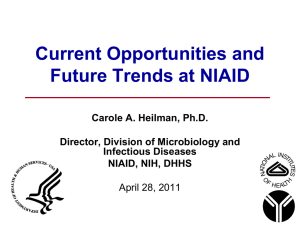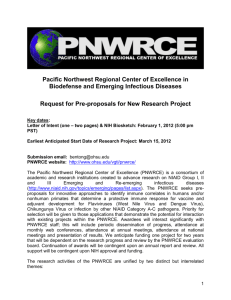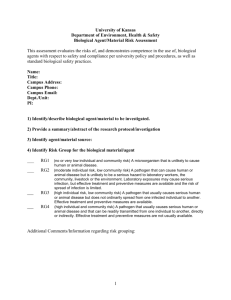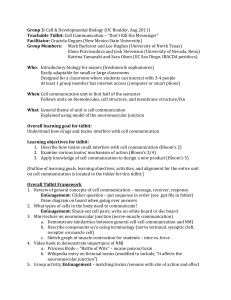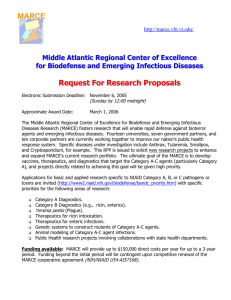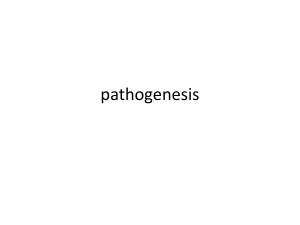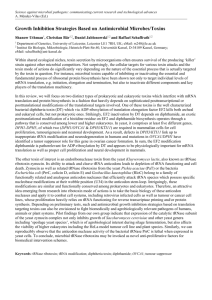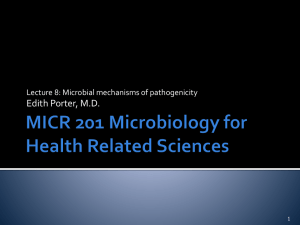FYI LOI due Oct
advertisement
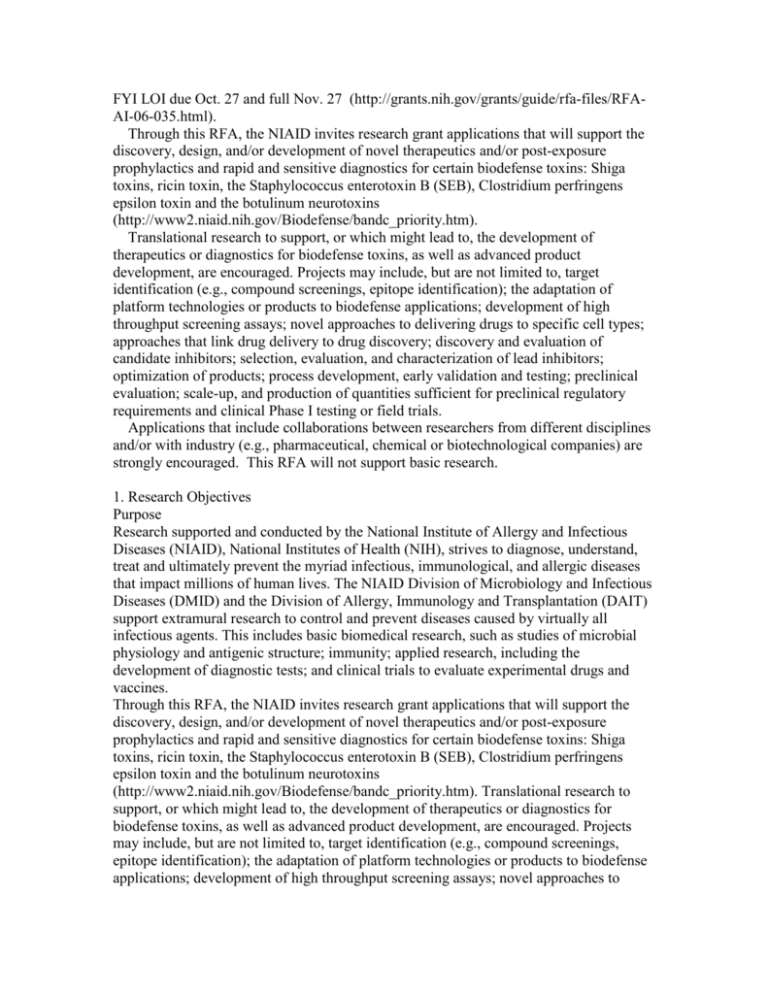
FYI LOI due Oct. 27 and full Nov. 27 (http://grants.nih.gov/grants/guide/rfa-files/RFAAI-06-035.html). Through this RFA, the NIAID invites research grant applications that will support the discovery, design, and/or development of novel therapeutics and/or post-exposure prophylactics and rapid and sensitive diagnostics for certain biodefense toxins: Shiga toxins, ricin toxin, the Staphylococcus enterotoxin B (SEB), Clostridium perfringens epsilon toxin and the botulinum neurotoxins (http://www2.niaid.nih.gov/Biodefense/bandc_priority.htm). Translational research to support, or which might lead to, the development of therapeutics or diagnostics for biodefense toxins, as well as advanced product development, are encouraged. Projects may include, but are not limited to, target identification (e.g., compound screenings, epitope identification); the adaptation of platform technologies or products to biodefense applications; development of high throughput screening assays; novel approaches to delivering drugs to specific cell types; approaches that link drug delivery to drug discovery; discovery and evaluation of candidate inhibitors; selection, evaluation, and characterization of lead inhibitors; optimization of products; process development, early validation and testing; preclinical evaluation; scale-up, and production of quantities sufficient for preclinical regulatory requirements and clinical Phase I testing or field trials. Applications that include collaborations between researchers from different disciplines and/or with industry (e.g., pharmaceutical, chemical or biotechnological companies) are strongly encouraged. This RFA will not support basic research. 1. Research Objectives Purpose Research supported and conducted by the National Institute of Allergy and Infectious Diseases (NIAID), National Institutes of Health (NIH), strives to diagnose, understand, treat and ultimately prevent the myriad infectious, immunological, and allergic diseases that impact millions of human lives. The NIAID Division of Microbiology and Infectious Diseases (DMID) and the Division of Allergy, Immunology and Transplantation (DAIT) support extramural research to control and prevent diseases caused by virtually all infectious agents. This includes basic biomedical research, such as studies of microbial physiology and antigenic structure; immunity; applied research, including the development of diagnostic tests; and clinical trials to evaluate experimental drugs and vaccines. Through this RFA, the NIAID invites research grant applications that will support the discovery, design, and/or development of novel therapeutics and/or post-exposure prophylactics and rapid and sensitive diagnostics for certain biodefense toxins: Shiga toxins, ricin toxin, the Staphylococcus enterotoxin B (SEB), Clostridium perfringens epsilon toxin and the botulinum neurotoxins (http://www2.niaid.nih.gov/Biodefense/bandc_priority.htm). Translational research to support, or which might lead to, the development of therapeutics or diagnostics for biodefense toxins, as well as advanced product development, are encouraged. Projects may include, but are not limited to, target identification (e.g., compound screenings, epitope identification); the adaptation of platform technologies or products to biodefense applications; development of high throughput screening assays; novel approaches to delivering drugs to specific cell types; approaches that link drug delivery to drug discovery; discovery and evaluation of candidate inhibitors; selection, evaluation, and characterization of lead inhibitors; optimization of products; process development, early validation and testing; preclinical evaluation; scale-up, and production of quantities sufficient for preclinical regulatory requirements and clinical Phase I testing or field trials. Applications that include collaborations between researchers from different disciplines and/or with industry (e.g., pharmaceutical, chemical or biotechnological companies) are strongly encouraged. This RFA will not support basic research. For some biodefense toxins, models for the testing of candidate therapeutics may be lacking, therefore, the development of new or improved animal models, as well as alternatives to animal models, will be responsive. However, the investigator must present strong evidence that an adequate model is lacking and that this will inhibit the testing of candidate therapeutics. The investigator must also present compelling justification that the proposed new or improved model is needed to facilitate the testing of candidate therapeutics, and is feasible and appropriate. NOTE: While clinical development strategies may be included within an overall product development plan, this RFA will NOT support clinical trials, as defined in http://www.niaid.nih.gov/ncn/glossary/default2.htm#clintrial. Applications requesting support for clinical trials will be viewed as unresponsive to this RFA and will be returned to the applicant without review. Collection and utilization of human derived material required for therapeutic or diagnostic development, or for compliance with regulatory requirements is considered responsive. Collection of all specimens must comply with the requirements and policies of the NIAID, DMID (http://www.niaid.nih.gov/dmid/clinresearch/) and 45 CFR Part 46. NOTE: Applications proposing the development of a therapeutic or diagnostic that does not focus on one or more of the biodefense toxins specified above (Shiga toxins, ricin toxin, the Staphylococcus enterotoxin B (SEB), Clostridium perfringens epsilon toxin and the botulinum neurotoxins) will be deemed unresponsive and will be returned to the applicant without review. NOTE: Applications addressing therapeutics or diagnostics for the NIAID Category B bacteria that produce Shiga toxins (diarrheagenic E. coli and Shigella) are not responsive to this RFA, and should be directed to the companion solicitation (RFA AI-06-029, http://grants.nih.gov/grants/guide/rfa-files/RFA-AI-06-029.html) NOTE: This RFA will NOT support research on environmental or workplace detection technologies or targets. Diagnostics applications must focus on the goal of detection and identification of toxins in human clinical samples. Partnerships A key component of this initiative is the development of partnerships between researchers from different disciplines and/or with industry. Cooperative research that brings together expertise in different aspects of research and product development is strongly encouraged. For the purpose of this RFA, industry is defined as large and small, domestic or foreign, pharmaceutical, biotechnology, bioengineering, and chemical companies. Since academic organizations are often the source of new candidate products, this RFA will also support a partnership between industry and collaborator(s) as necessary from academic and non- profit research organizations. Such partnerships are strongly encouraged, but not required. The Principal Investigator of the project may be affiliated with any of the eligible institutions listed in Section III below. It is expected that in the application the Principal Investigator will describe in detail the relevant product development expertise and track record available within the team. The NIH project scientist assigned to the project post-award will ensure that issues are addressed and milestones met during product development. It is recognized that early research and development steps may not be successful, and may need to be modified or reworked. NIAID staff, through the cooperative agreement grant mechanism, will be actively involved in evaluating progress toward project milestones and determining whether continued investment is warranted. To receive consideration for funding of each successive year, the annual progress report and an updated product development plan must be received 2 months prior to the end of the current funding period, demonstrating that the milestones defined for that funding year have been met. Background The NIH and other agencies in the Department of Health and Human Services (DHHS) are currently supporting extramural and intramural projects to develop new products to protect the public from the health consequences resulting from the use of biological agents in acts of terrorism or war. The biological agents deemed to pose the greatest threat to civilian populations are prioritized in the NIAID Category A, B and C priority pathogens and toxins list, which is available at: http://www2.niaid.nih.gov/Biodefense/bandc_priority.htm. The NIAID convened three Blue Ribbon Panels to address the research priorities for Category A pathogens and toxins, Category B and C pathogens and toxins, and immunology research. The research agendas that resulted from these three meetings are published at: http://www.niaid.nih.gov/biodefense/research/biotresearchagenda.pdf, http://www.niaid.nih.gov/biodefense/research/categorybandc.pdf and http://www.niaid.nih.gov/publications/pdf/biodimmunpan.pdf. In addition to the NIAID research agendas, the DHHS has identified the highest priority products for bioterror preparedness (http://www.niaid.nih.gov/biodefense/research/high_priority.htm). Several expert panel meetings were also convened to address research needs for developing therapeutics or diagnostics for the botulinum neurotoxins, ricin, and Shiga toxins (http://www3.niaid.nih.gov/Biodefense/PDF/bot_toxins.pdf; http://www3.niaid.nih.gov/Biodefense/PDF/bot+toxins+mtg.pdf; http://www3.niaid.nih.gov/Biodefense/PDF/Report+BoNT.pdf; http://www3.niaid.nih.gov/Biodefense/ricin_meeting.pdf; http://www.niaid.nih.gov/dmid/enteric/hus_prevent.htm). To meet the objectives outlined by the Blue Ribbon Panels, it is imperative that promising findings are translated rapidly into product development. The involvement of diverse disciplines within academia and industry in basic science, translational research and product development is needed to bring sufficient expertise to bear on the development of well-designed therapeutics and medical diagnostics. Research Goals and Objectives The objective of this RFA is to support scientifically sound, original and innovative research that will advance the development of a therapeutic or diagnostic that is specific for one or more of the following toxins: Shiga toxins, ricin toxin, the Staphylococcus enterotoxin B (SEB), Clostridium perfringens epsilon toxin or the botulinum neurotoxins. Projects are not required to result in a final product since clinical trials are not supported; however proposals to make significant progress along the pre-clinical research and product development pathway are expected. Therapeutics development may extend to the point where the R34 Clinical Trial Planning Grants and U01 Clinical Trial Implementation Cooperative Agreements (http://www.niaid.nih.gov/ncn/clinical/R34.htm) offer the logical next step. Diagnostic development should target demonstrable needs and should consider evaluation and validation with appropriate clinical specimens. Research and product development projects that address multiple agents such as broad spectrum therapeutics, novel drug families, and multiplex diagnostics are particularly encouraged, especially when a clearly demonstrable need is shown, and a pathway to clinical or field use is presented. All applications should define the proposed project goal, describe the proposed final product, and provide a schedule or timeline for goal attainment with measurable interim objectives (essential milestones). A specific product profile defined by licensing indication is not requested. When appropriate, research plans should demonstrate an awareness of the guidelines that govern GLP (as defined by 21 CFR Part 58) and GMP (as defined by 21 CFR Part 211) manufacturing, and/or IND/IDE enabling studies that will be performed under this award as they would be applied to eventual product/device licensure in the U.S. The NIAID recognizes that critical aspects of the product development pathway such as GLP, cGMP production, or diagnostic validations are not inherently innovative; however, innovation is encouraged where it is appropriate to reduce project risk or to facilitate the efficient accomplishment of goals. Phase I, II, and III clinical trials and field trials are not supported by this RFA. However, in the case of diagnostics, it is expected that appropriate human specimens will be used to establish proof of principle, show that performance specifications can be met, to demonstrate a level of utility that exceeds existing systems, and to clearly place the proposed product on a pathway to FDA review. Collection of all specimens must comply with the requirements and policies of 45 CFR Part 46, and the NIAID, DMID (http://www.niaid.nih.gov/dmid/clinresearch/). Therapeutics for Biodefense Development of biodefense therapeutics is a key national priority. Applications are invited that will lead to the development of therapies against Shiga toxins, ricin toxin, the Staphylococcus enterotoxin B (SEB), Clostridium perfringens epsilon toxin and the botulinum neurotoxins or the physiological insults that they cause. The NIAID encourages the multidisciplinary collaboration and expertise of toxin researchers, medicinal chemists, clinicians, and structural biologists needed to address discovery, development, evaluation, and delivery of therapies. Some of the challenges of developing post-exposure treatments for these toxins include the following: toxin is free in the circulation for only a brief period of time (hours to days); the therapeutic window for conventional anti-toxins (e.g., antibodies) that target free toxin or block the binding of toxin to cellular receptors is short; and the patient is asymptomatic prior to the intracellular internalization of the toxin. The greatest clinical benefit would be derived from therapies capable of blocking or reversing either the action of the toxin following cellular internalization or the host responses to the toxin that result in disease. Projects may include, but are not limited to, one or more of the following areas: Identification, validation, or further study of drug targets either by examining the toxin, or by examining and mitigating the effects of the toxin on the physiological and immunological processes of the human host; Performing studies such as molecular modeling, screening libraries, and medicinal chemistry to rationally design and optimize candidate compounds for preclinical studies; Exploration/extraction of the active components of natural products as potential sources for drug development; Development of new or improved animal models, or non-animal alternatives, required to test candidate therapeutics, if appropriate and justified; Pre-clinical development of novel therapeutic technologies including immunotherapeutics, monoclonal antibodies, and siRNA; Performing reiterative design, chemical synthesis and in vitro analysis to develop a lead compound; Optimization of lead compounds to improve the therapeutic activity, pharmacology, and safety of the drug candidate; Synthesizing, purifying, and testing sufficient quantities of lead compound(s) for efficacy and toxicity studies in model assays and preclinical in vitro or in vivo models; Performing preliminary pharmacokinetic and pharmacodynamic analyses; assessing/optimizing bioavailability and mechanism of action; Determining drug and metabolite interactions in host processes; Process development for the manufacturing of drugs, including GLP and GMP, QA/QC, methods for product recovery, characterization, purification, identity, stability, etc.; Performing required benchmarks for successful submission and review of an IND application by the FDA (http://www.fda.gov/cder/regulatory/default.htm), in preparation for moving a drug candidate into Phase I clinical trials. NOTE: Interventions that can block or reverse the effects of intoxication after the toxins have reached their intracellular site(s) of action are of particular interest. NOTE: For therapeutics development applications, of particular interest are projects that incorporate formulation strategies that optimize the properties of the resulting product. NOTE: Applications that do not address the development of a therapeutic or diagnostic for Shiga toxins, ricin toxin, the Staphylococcus enterotoxin B (SEB), Clostridium perfringens epsilon toxin or the botulinum neurotoxins will be deemed unresponsive and will be returned to the applicant without review. NOTE: Applications addressing therapeutics or diagnostics for the NIAID Category B bacteria that produce Shiga toxins (diarrheagenic E. coli and Shigella) are not responsive to this RFA, and should be directed to the companion solicitation (RFA AI-06-029, http://grants.nih.gov/grants/guide/rfa-files/RFA-AI-06-029.html). NOTE: Clinical trials will NOT be supported. Diagnostics for Biodefense There is an urgent need for easy to use, rapid, and cost-effective medical diagnostics for public health laboratories, hospital-based clinical laboratories, field, and point-of-care use to diagnose individuals exposed to and/or intoxicated with Shiga toxins, ricin toxin, the Staphylococcus enterotoxin B (SEB), Clostridium perfringens epsilon toxin and the botulinum neurotoxins. NIAID goals include supporting the development of diagnostics that identify these toxins and instruct appropriate therapy for individuals who are presymptomatic, symptomatic, non-responding to treatment, or have non-specific symptoms. The design and development of diagnostics should be focused on the steps critical to product development and with an understanding of the clinical needs and the appropriate sensitivity required for each toxin. Medical diagnostics that perform differential diagnoses are of high priority. The development of medical diagnostics that use multiplex, platform technologies is encouraged and can include other agents in addition to Shiga toxins, ricin toxin, the Staphylococcus enterotoxin B (SEB), Clostridium perfringens epsilon toxin or the botulinum neurotoxins, but must be focused on rapidly distinguishing whether an individual is intoxicated with one of these toxins or by a common disorder with similar, generalized symptoms. Projects may include, but are not limited to, one or more of the following areas: Technologies and assays that demonstrate the highest performance for their intended use to detect toxins in relevant clinical samples (e.g., sensitivity, specificity, rapidity, ruggedness, ease-of-use and cost-effectiveness); Methods for rapid sample preparation, processing, and concentration; Improved technologies, methodologies, and reagents for rapid, multiplexed diagnostics; Technologies that integrate multiple methods of parallel measurements for detection in the same platform, such as identifying nucleic acids, proteins, and other targets from agents in the same assay; Technologies targeting multiple biomarkers or signature profiles with high throughput screening, to simultaneously identify multiple agents, and/or human immune or other physiological responses during infection (e.g., platform-based technologies); Methods capable of high throughput, robotic, and automated data output and analyses; Process development for the manufacturing of diagnostic components, including QA/QC methods for reagent recovery, characterization, purification, identity, and stability; and Performing required benchmarks for successful submission and review of a 510(k) or PMA application by the FDA (http://www.fda.gov/cdrh/index.html). NOTE: Applications proposing the development of a diagnostic or therapeutic that do not include Shiga toxins, ricin toxin, the Staphylococcus enterotoxin B (SEB), Clostridium perfringens epsilon toxin or the botulinum neurotoxins will be deemed unresponsive and will be returned to the applicant without review. NOTE: This program will NOT support research on the development or deployment of devices for the detection of agents in foods, fomites, or environmental specimens. Such applications will be deemed unresponsive and returned to the applicant without peer review. NOTE: Applications addressing therapeutics or diagnostics for the NIAID Category B bacteria that produce Shiga toxins (diarrheagenic E. coli and Shigella) are not responsive to this RFA, and should be directed to the companion solicitation (RFA AI-06-029, http://grants.nih.gov/grants/guide/rfa-files/RFA-AI-06-029.html). See Section VIII, Other Information - Required Federal Citations, for policies related to this announcement.

